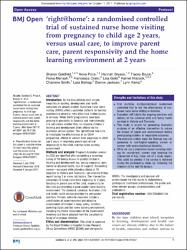Please use this identifier to cite or link to this item:
http://hdl.handle.net/11054/1080| Title: | 'right@home': a randomized controlled trial of sustained nurse home visiting from pregnancy to child age 2 years, versus usual care, to improve parent care, parent responsivity and the home learning environment at 2 years. |
| Authors: | Goldfield, Sharon Price, Anna Bryson, Hannah Bruce, Tracey Mensah, Fiona Orsini, Francesca Gold, Lisa Hiscock, Harriet Smith, Charlene Bishop, Lara Jackson, Dianne Kemp, Lynn |
| Issue Date: | 2017 |
| Publication Title: | BMJ Open |
| Volume: | 7 |
| Issue: | 3 |
| Start Page: | 1 |
| End Page: | 15 |
| Abstract: | This is a multisite trial conducted in the states of Victoria and Tasmania in Australia where each state is responsible for the delivery of their local healthcare system. Participants were recruited from the public maternity hospitals servicing four local government areas (councils) in Victoria, including Ballarat Health Services. By the time children start school, inequities in learning, development and health outcomes are already evident. Sustained nurse home visiting (SNHV) offers a potential platform for families experiencing adversity, who often have limited access to services. While SNHV programmes have been growing in popularity in Australia and internationally, it is not known whether they can improve children's learning and development when offered via the Australian service system. The right@home trial aims to investigate the effectiveness of an SNHV programme, offered to women from pregnancy to child age 2 years, in improving parent care of and responsivity to the child, and the home learning environment. Pregnant Australian women (n=722) are identified after completing a screening survey of 10 factors known to predict children's learning and development (eg, young pregnancy, poor mental or physical health, lack of support). Consenting women—surveyed while attending clinics at 10 hospitals in Victoria and Tasmania—are enrolled if they report having 2 or more risk factors. The intervention comprises 25 home visits from pregnancy to 2 years, focusing on parent care of the child, responsivity to the child and providing a good quality home learning environment. The standard, universal, Australian child and family health service provides the comparator (control). Primary outcome measures include a combination of parent-reported and objective assessments of children's sleep, safety, nutrition, parenting styles and the home learning environment, including the Home Observation of the Environment Inventory and items adapted from the Longitudinal Study of Australian Children. |
| URI: | http://hdl.handle.net/11054/1080 |
| ISSN: | 2044-6055 |
| DOI: | http://dx.doi.org/10.1136/bmjopen-2016-013307 |
| Internal ID Number: | 01050 |
| Health Subject: | CHILD EARLY CHILDHOOD INTERVENTIONS FAMILY HEALTH HOUSE CALLS LONGITUDINAL STUDIES PARENTING PARENTS OUTCOME ASSESSMENT (HEALTH CARE) SURVEYS AND QUESTIONNAIRES TASMANIA VICTORIA, AUSTRALIA |
| Type: | Journal Article Article |
| Appears in Collections: | Research Output |
Files in This Item:
| File | Description | Size | Format | |
|---|---|---|---|---|
| Goldfield et al. right@home.pdf | 1.7 MB | Adobe PDF |  View/Open |
Items in DSpace are protected by copyright, with all rights reserved, unless otherwise indicated.
